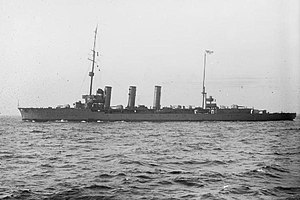 SMS Brummer underway
| |
| History | |
|---|---|
| Name | Brummer |
| Builder | AG Vulcan, Stettin |
| Laid down | 24 April 1915 |
| Launched | 11 December 1915 |
| Commissioned | 2 April 1916 |
| Fate | Scuttled in Scapa Flow on 21 June 1919 |
| General characteristics | |
| Class and type | Brummer-class light cruiser |
| Displacement | |
| Length | 140.4 m (460 ft 8 in) |
| Beam | 13.2 m (43 ft 4 in) |
| Draft | 6 m (19 ft 8 in) |
| Installed power |
|
| Propulsion |
|
| Speed | 28 knots (52 km/h; 32 mph) |
| Range | 5,800 nmi (10,700 km; 6,700 mi) at 12 kn (22 km/h; 14 mph) |
| Complement |
|
| Armament |
|
| Armor |
|
SMS Brummer was a minelaying light cruiser of the German Kaiserliche Marine; she was the lead ship of her class. Her sister ship was Bremse. Brummer was laid down at AG Vulcan's shipyard in Stettin, Germany, on 24 April 1915 and launched on 11 December 1915 and completed on 2 April 1916. Armed with a main battery of four 15-centimeter (5.9 in) guns in single mounts, she carried 400 mines.
Despite being designed as a minelayer, the German Navy never operated her as such. She and her sister were used to raid a British convoy to Norway in October 1917. The two cruisers sank two escorting destroyers and nine of the twelve merchant ships of the convoy. The Kaiserliche Marine considered sending the two ships to attack convoys in the Atlantic Ocean, but the difficulties associated with refueling at sea convinced the Germans to abandon the plan. Brummer was included in the list of ships interned at Scapa Flow following the Armistice. On 21 June 1919, the commander of the interned fleet, Rear Admiral Ludwig von Reuter, ordered the scuttling of the fleet. Brummer was successfully scuttled, and unlike most of the other wrecks, she was never raised for scrapping.